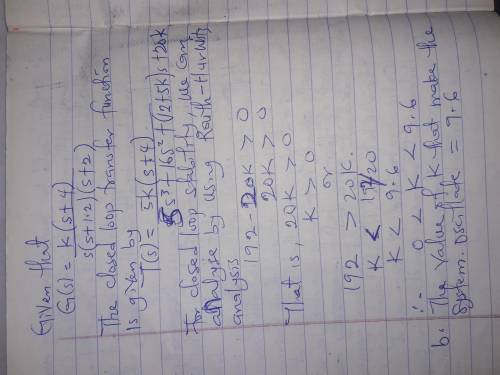Given the unity feedback system
G(s)= K(s+4)/s(s+1.2)(s+2)
Find:
a. The ra...

Engineering, 29.07.2020 01:01 yoyoho6218
Given the unity feedback system
G(s)= K(s+4)/s(s+1.2)(s+2)
Find:
a. The range of K that keeps the system stable
b. The value of K that makes the system oscillate
c. The frequency of oscillation when K is set to the value that makes the system oscillate

Answers: 2


Other questions on the subject: Engineering

Engineering, 04.07.2019 18:20, jessie8022
Apiston-cylinder device contains 0.1 m3 of liquid water and 0.9 m3 of water vapor in equilibrium at 800 kpa. heat is transferred at constant pressure until the temperature of water reaches 350 °c. determine (a) the quality of water at the initial state (b) the work associated with this process, (c) the heat associated with this process.
Answers: 2

Engineering, 04.07.2019 19:10, rhiannpelham60
The maximum shear stress and maximum flexural stress occur at the same location along a beam subjected to a non-uniform bending load. a)-trune b)- false
Answers: 2

Engineering, 06.07.2019 02:30, onlymyworld27
In a unit cell of fcc structure, indicate the position of one of the tetrahedral interstitial sites by plotting the corresponding tetrahedron. do the same for one of the octahedral interstitial sites (in a separate fcc unit cell). mark the positions of all the tetrahedral and octahedral interstitial sites in the unit cells. how many equivalent tetrahedral sites and how many equivalent octahedral sites are contained in a fcc unit cell, respectively. what is the coordination number for a tetrahedral site and what is the coordination number for an octahedral site?
Answers: 2

Engineering, 06.07.2019 03:10, netflixacc0107
Consider two concentric spheres forming an enclosure with diameters of 12 cm and 18 cm the spheres are maintained at uniform temperatures ti-50°c and t2 = 250°c and have emissivities .45 and .8, respectively. determine the net rate of radiation heat transfer between the two spheres per unit surface area.
Answers: 1
You know the right answer?
Questions in other subjects:

Social Studies, 30.09.2019 16:30

Biology, 30.09.2019 16:30


History, 30.09.2019 16:30

Mathematics, 30.09.2019 16:30

History, 30.09.2019 16:30

History, 30.09.2019 16:30


Physics, 30.09.2019 16:30

Biology, 30.09.2019 16:30





